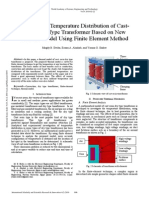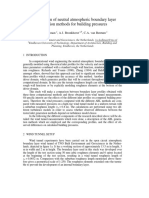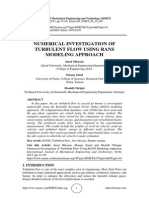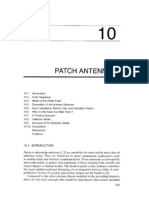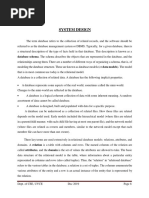Design and Simulation of MEMS-based Dual-Axis Uidic Angular Velocity Sensor
Design and Simulation of MEMS-based Dual-Axis Uidic Angular Velocity Sensor
Uploaded by
Rahul ParkCopyright:
Available Formats
Design and Simulation of MEMS-based Dual-Axis Uidic Angular Velocity Sensor
Design and Simulation of MEMS-based Dual-Axis Uidic Angular Velocity Sensor
Uploaded by
Rahul ParkOriginal Title
Copyright
Available Formats
Share this document
Did you find this document useful?
Is this content inappropriate?
Copyright:
Available Formats
Design and Simulation of MEMS-based Dual-Axis Uidic Angular Velocity Sensor
Design and Simulation of MEMS-based Dual-Axis Uidic Angular Velocity Sensor
Uploaded by
Rahul ParkCopyright:
Available Formats
Sensors and Actuators A 189 (2013) 6166
Contents lists available at SciVerse ScienceDirect
Sensors and Actuators A: Physical
journal homepage: www.elsevier.com/locate/sna
Design and simulation of MEMS-based dual-axis uidic angular velocity sensor
Thien Xuan Dinh , Yoshifumi Ogami
Ritsumeikan University, 1-1-1 Noji-Higashi, Kusatsu, Shiga 525-8577, Japan
a r t i c l e
i n f o
a b s t r a c t
In this paper, we present the design and simulation of a microelectromechanical system (MEMS)-based uidic angular velocity sensor that can simultaneously detect two components of angular velocity (two degrees of freedom). The sensor includes three layers, in which only the layer containing in-plane hotwire anemometers requires a standard MEMS process with one mask. The other layers can be fabricated using either hot embossing or conventional machining. In the sensor, four jets comprising two perpendicular pairs of ows are generated by a piezoelectric-actuated diaphragm through a valveless network channel. We consider two designs to optimize the angular velocity sensor structure with an objective function relating the output voltage to the angular velocity. 2012 Elsevier B.V. All rights reserved.
Article history: Received 5 March 2012 Received in revised form 3 September 2012 Accepted 1 October 2012 Available online 17 October 2012 Keywords: Fluidic gyroscope Jet ows Sensitivity Microelectromechanical system
1. Introduction The high demand for inertial measurement devices, which includes automotive systems, aerospace industries, robotics, smart phones, and gesture recognition, has led to a large amount of research on microelectromechanical system (MEMS) angular velocity sensors. Although ber optic angular velocity sensors provide extremely precise information [1], integrating the laser source, mirror, and coupler into a microelectromechanical system (MEMS) chip remains a challenge. Alternatively, vibratory angular velocity sensors are compatible with MEMS techniques [2], although the moving parts of such devices would be fragile and suffer from squeeze-lm air damping, thus necessitating a complicated packaging process. In contrast, uidic angular velocity sensors offer a solution because they do not require a vibrating mass. However, to the best of our knowledge, most of the developed uidic angular velocity sensors can only sense one or two components of angular motion with a partial MEMS technique [3]. In this study, we aim to realize MEMS-based uidic angular velocity sensors that meet the actual market requirements. The structure of the device is compatible with planar layer-by-layer geometries, which are easily produced using lithography-based microfabrication techniques with only one mask.
2. Design and working principle of angular velocity sensor The structure of the angular velocity sensor includes three layers: the top, hotwire anemometer, and bottom layers, as in Fig. 1(a)(c), respectively. The top layer comprises a pump chamber, drive channel, and main chamber in which the ow is generated. This layer can be fabricated using conventional machining (e.g., computer numerical control machine) or a hot embossing technique. The hotwire anemometer layer contains in-plane hotwire anemometers on the top of the cavities to sense the angular velocity. The bottom, hotwire anemometer, and top layers are assembled, and the top of the pump chamber is closed by a circular diaphragm, as in Fig. 1(d). The two designs considered in this paper differ in the shape of the main chamber, whereas their other parts have the same dimensions and shapes, as shown in Fig. 1(e). Type I has a wider main chamber at the nozzle than Type II. In the current investigation, the thickness of the top layer is 1 mm, which comprises the 0.5-mm depth of the drive-channel, 0.3-mm depth of the pump chamber, and 0.2-mm layer between the drive-channel and pump chamber. The depth of the hotwire anemometer layer is 0.5 mm. Therefore, the main chamber, including the cavity, has a depth of 1 mm. The diameter of the pump chamber is 16 mm. These dimensions are n-fold depending on the hot embossing fabrication technique of the top layer because the working principle is valid to the n-fold scale. The principle of using valveless rectication (i.e., without requiring check valves) to generate ow in the sensor is shown in Fig. 2. In the pump phase (i.e., when the diaphragm is deected downward, as in Fig. 2(a)), the uid in the pump chamber is pushed straight into the drive channels more easily than it is pushed into the main chambers. In contrast, in the suction phase (i.e., when the diaphragm
Corresponding author. E-mail address: thien@cfd.ritsumei.ac.jp (T.X. Dinh). 0924-4247/$ see front matter 2012 Elsevier B.V. All rights reserved. http://dx.doi.org/10.1016/j.sna.2012.10.001
62
T.X. Dinh, Y. Ogami / Sensors and Actuators A 189 (2013) 6166
Fig. 1. Conguration of sensor. (a) The top layer containing the pump chamber, drive channel, and main chambers. (b) The hotwire anemometer layer containing in-plane hotwire anemometers. (c) The bottom layer. (d) The cut along the AA path. The bold arrows indicate the main ow in the sensor. (e) Comparison between two designs: Type I and Type II. They differ in the shape of the main chamber, whereas the other parts have identical dimensions.
Fig. 2. Principle for generating ow in sensor. The bottom gures show the view at the corner of the sensor bounded by the AB path, whereas the top gures show the cut along the AA line in Fig. 1(a). The thicknesses of the bold arrows qualitatively represent the ow rates and their directions in the designated location. (a) Typical ows in the pump phase. (b) Typical ows in the suction phase.
moves upward, as in Fig. 2(b)), because of the Venturi effect and nozzle/diffuser effect, the ow returns to the pump chamber from both the main chambers and drive channels with the same order of magnitude. Consequently, a net ow that travels from the pump chamber to the drive channel, and then to the main chamber, is generated [4]. The working principle for measuring the angular velocity is schematically shown in Fig. 3. When an angular velocity is applied about the Y-axis, the jet ows in two opposite main chambers
along X-axis are deected under the Coriolis effect, which disrupts the equivalent velocity distribution on Y-hotwire anemometer (1) and Y-hotwire anemometer (2). The difference in velocity on the hotwire anemometers results in a difference in temperature, which in turn leads to a difference in resistance between the two hotwire anemometers because of the dependence of the heat transfer coefcient on velocity. A Wheatstone bridge circuit is used to convert the resistance changes into an output voltage. Consequently, the angular velocity can be measured from the output voltage signal. The angular velocity about the X-axis is similarly obtained. 3. Simulation Because the ow is generated by the vibration of the diaphragm sealed on the top of the pump chamber, the air inside the sensor is compressed or extended by the oscillation of the diaphragm. To
Fig. 3. Working principle of sensor when angular velocity is applied about Y-axis. The gure shows the cut along the BB path in Fig. 1(a).
T.X. Dinh, Y. Ogami / Sensors and Actuators A 189 (2013) 6166
63
Fig. 4. Deection of circular diaphragm with clamped edge under load uniformly distributed over concentric circulate portion of radius b.
encompass these effects, the governing equations of the motion of a compressible Newtonian uid are used as follows: + u=0 t u + (u ) u = p + ( u) 2 u t cp T + (u ) cp T = ( T ) t (1) (2)
Fig. 5. Variation in jet velocity at nozzle with time.
(3) The values of these integrals are numerically obtained by using the Simpson method. The shape function of the deection is (r ) = z (r ) z (0) (8)
Here, u, p, and T denote the velocity vector, pressure, and temperature of the ow eld, respectively; , , , and cp are the dynamic viscosity, density, thermal conductivity, and specic heat of the air, respectively; and is the angular velocity of the angular velocity sensor. The relation between the pressure and density of the air can be given by the following state equation of an ideal gas, p = Ru T/Mw , where Ru is the universal gas constant and Mw is the air molecular weight. For the circular diaphragm used in this sensor, the rst axisymmetric deection mode is considered because this mode has a large deforming volume. Therefore, the time-dependent motion of a radial position r on the diaphragm can be decomposed as z (r, t ) = Z (t )(r ), where Z(t) is the central displacement of the diaphragm and (r) is the shape function of the deection [5]. Under a sinusoidal external force with a frequency of f on the diaphragm, the central displacement is Z (t ) = sin(2 ft ) (4)
The deection amplitude (of the order of tens of microns) is small compared to the depth of the pump chamber (300 m). Therefore, it is unnecessary to use the deformed mesh in the simulation. The local rate of deformation of the diaphragm is converted to a local velocity applied to the diaphragm surface as
v(r, t ) = 2 f cos(2 ft )(r )
(9)
To use the piezoelectric force to vibrate the diaphragm, the diaphragm comprises a circular piezoelectric disc concentrically pasted on a circular metal (e.g., brass, stainless steel) disc, as in Fig. 4. The radii of the metal disc and piezoelectric disc are dened, respectively, as a and b. By assuming that the piezoelectric force is uniform on the piezoelectric disc with intensity q (N/m2 ), we obtain the deections of position r for the outer portion (r b)
b
The reference uid properties, i.e., of ideal air, are as follows: temperature = 298 K, molecular weight Mw = 28.96 g/mol, viscosity = 1.789 105 Pa s, thermal conductivity = 2.42 103 W/m-K, and specic heat cp = 1006.43 J/kg K. The estimated Knudsen number (Kn = F /L), where F 100 nm is the mean free path of air, is less than 103 . Hence, the continuum hypothesis and non-slip condition at the walls are applicable. The time step is determined as t = 1/(fN) according to the excitation frequency on the diaphragm, where N is an arbitrary integer. For the exact reproduction of the ow behavior in one cycle of PZT diaphragm oscillation, N is selected to be greater than 40. 4. Simulation results 4.1. Flow characteristics Fig. 5 shows the variation in the spatially averaged axial velocity at the nozzle outlet, UJ , against the dimensionless time t f. We observe that the ow attains a steady state after about ten cycles of diaphragm vibration. We also observe that UJ completes one cycle during the dimensionless time t f = 1. In other words, the ow in the main chamber oscillates at the same frequency as that of the diaphragm. Fig. 6 shows the responses of UJ and its amplitude to the frequency applied to the diaphragm. Below a certain frequency, the gas has sufcient time to ow away from the pump chamber. However, above this frequency, the gas is trapped and squeezed under the vibrating diaphragm. This explains why UJ attains a maximum value at a certain frequency but then decreases with increasing frequency, as in the behavior of a spring. The gure shows that the resonant frequency of the response is f0 = 7.0 kHz. The diaphragm is considered as a spring with a spring constant of K within the frequency domain of less than f0 . Given that the
z (r ) = C
0
zo (r, r )r dr ,
(5)
and for the inner portion (r b)
r b
z (r ) = C
0
zo (r, r )r dr +
r
zi (r, r )r dr
(6)
where C = q/(4D) [6]. The rigidity D can be computed from the Young modulus E, Poissons ratio D , and thickness h of the metal 2 )). The inner integral functions of Eqs. disc as D = Eh3 /(12(1 D (5)(6) are dened as zo (r, r ) = (a2 r 2 )(a2 + r 2 ) + (r 2a2
2
+ r 2 ) log + r ) log
2
r a r a
(7)
(a2 + r 2 )(a2 r 2 ) zi (r, r ) = + (r 2a2
We note that Eqs. (5)(6) are integrable. However, the analytic solution results in a long expression; thus, it is not shown here.
64
T.X. Dinh, Y. Ogami / Sensors and Actuators A 189 (2013) 6166
Fig. 8. Velocity proles along lines containing Y-hotwire anemometer (1) and Yhotwire anemometer (2) under Y-angular velocity of 300 rpm. Fig. 6. Response of jet velocity at nozzle on application of exciting frequency to diaphragm.
difference in velocity on the two hotwire anemometers is clearly observed. 4.2. Angular velocity measurement As discussed in [8], the frequency at which the attenuation of a hotwire anemometer begins is f 40Df /(2 l2 ) (Df and l are the thermal diffusivity and length of the hotwire anemometer, respectively), and the attenuation extends to frequencies of the order of 100f. In the current examination, f is 5.0 kHz (for a p-type hotwire anemometer, Df 2.04 m2 /s and l = 500 m) and the ow in the main chamber oscillates sinusoidally with the resonant frequency of the device (i.e., 7.0 kHz). This implies that the frequency of the ow is within the lowest range of frequencies at which the attenuation effect begins. However, the effects of this attenuation on the measured mean velocity may be small [9]. Therefore, we can characterize the heat transfer between the hotwire anemometer and surrounding air in the equilibrium condition by using the timeaveraged velocity of the air. The performance of the hotwire anemometer is characterized by a constant current mode. The temperature of the hotwire anemometer THW heated by current I is determined from the equilibrium equation of the heat transfer at steady state between the hotwire anemometer and air I 2 R = hA(THW Ta ) (10)
squeezing effect has not inuenced the angular velocity sensor and that the compressibility of the gas is ignored because /d 1, the inertia of the gas relative to that of the diaphragm can be ignored. The equivalent mass of the diaphragm is scaled with the central a velocity as M = h D 0 2 2 (r )rdr , where D is the density of the metal disc and (r) is the shape function of the deection of the diaphragm [7]. As shown in Eq. (6), the equivalent spring constant of the diaphragm is determined as K = 4 Db2 /k1 , where k1 is the constant computed by substituting r = 0 into Eq. (6). The resonant frequency of the diaphragm is fd0 = (K/M)1/2 . Clearly, fd0 should equal f0 ; the thickness of the diaphragm is then estimated to be 0.16 mm. Fig. 7 shows the time-averaged velocity (herein, after referred to as velocity) distributions on cross sections of the four main chambers of the angular velocity sensor. In our present simulation, the time-averaged values are computed for the period of 30 t f 50. This ensures that the ow in the main chamber has reached a steady state and there is sufcient time to obtain averaged values. The gure indicates that four jets with two perpendicular jets in a pair are created. These jets can measure three components of angular velocity simultaneously. Fig. 8 plots the velocity prole across the main chamber on the hotwire anemometer plane when Y-angular velocity is applied. A
where A is the surface area of the hotwire anemometer, h is the heat transfer coefcient, and Ta is the reference temperature. In this equation, the resistance of the hotwire anemometer R is calculated from the thermoresistive effect R = Ra [1 + (THW Ta )] (11)
in which Ra and are the resistance at temperature Ta and the temperature coefcient of resistance of the hotwire anemometer, respectively. For forced convection with velocity U and low velocity calibration, the heat transfer coefcient is [10]
.439 h = (0.384 + 0.581Re0 ) e
Tf Ta
0.154
DHW
(12)
where DHW is the effective diameter of the hotwire anemometer. The lm temperature Tf is dened as (THW + Ta )/2, and the effective Reynolds number Re is Re2 e = Re
Fig. 7. Four jets created in four main chambers. The color bar indicates the velocity magnitude (m/s). (For interpretation of the references to color in this gure legend, the reader is referred to the web version of the article.)
1+
1.06Ra0.836 Re2
(13) is the viscosity of the gas and
In Eq. (13), Re = UDHW / , where Ra is the Rayleigh number.
T.X. Dinh, Y. Ogami / Sensors and Actuators A 189 (2013) 6166
65
Fig. 9. Wheatstone bridge circuit used to measure difference in resistance between RHW1 and RHW2 .
Given that the hotwire anemometer experiences a range of velocities, as shown in Fig. 8, the hotwire anemometer is divided into numerous innitesimal segments, where the velocity on each segment can be assumed to be constant. The number of segments is 50 in this study. On each segment, the heat transfer between the gas and hotwire anemometer is obtained by solving Eqs. (10)(13) iteratively. The angular velocity is dened as (X , Y , Z ) with respect to the X-, Y-, and Z-directions. The difference in resistance between hotwire anemometers (1) and (2) is obtained using the Wheatstone bridge circuit, as in Fig. 9. The output to measure the angular velocity will be RHW1 RHW2 G = E R + RHW1 R + RHW2 (14)
Fig. 11. Velocity proles along Y-direction at X = 4.75 mm, Z = 0.0 mm in the cases with and without Z-angular velocity.
Fig. 10 plots the variation in the simulated output of the Yhotwire anemometers, G/E, against the applied Y-angular velocity for the two sensor designs. This shows that linear variation is attained in both designs and the G/E of the narrow main chamber is slightly smaller than that of the wide main chamber. The Y-hotwire anemometers are symmetrically located with respect to the X-axis; hence, the velocity distributions on these hotwire anemometers are identical for any X . Furthermore, because the Y-hotwire anemometers are at the same elevation with respect to the Z-axis, the angular velocity Z does not cause different velocities on the Y-hotwire anemometers. In other words, the effects of the X- and Z-angular velocities on the output of the Y-hotwire anemometers are ignored. Fig. 11 plots the velocity proles along the Y direction at X = 4.5 mm on the hotwire anemometer plane with and without the Z-angular velocity. This gure indicates that the jet ow can be used to detect the Z-angular velocity by using a pair of Z-hotwire anemometers located as shown in Fig. 1(b). Similarly, to compute the output, G/E, of the XY hotwire anemometers, the output of the
Fig. 12. Variation in output of Z-hotwire anemometers with Z-angular velocity applied to sensor.
Z-hotwire anemometer is obtained. Fig. 12 shows that the variation in G/E of the Z-hotwire anemometers with a Z-angular velocity is linear with the narrow main chamber, whereas G/E is unpredicted with the wide main chamber. A possible explanation is that the circulation ows in the main chamber are diminished with a narrower space, as shown in Fig. 13.
Fig. 10. Variation in output voltage of Y-hotwire anemometers with Y-angular velocity applied to sensor.
Fig. 13. Mean streamlines in main chambers of (a) Type I and (b) Type II.
66
T.X. Dinh, Y. Ogami / Sensors and Actuators A 189 (2013) 6166
the standard MEMS and hot embossing fabrication processes. A three-dimensional transient compressible ow simulation model was used to investigate the ow in the sensor, including the effect of an angular velocity. The heat transfer between the air and hotwire anemometers was calibrated for a low velocity. With the primary optimization of the sensor structure, the linear variation in the output voltage with the applied angular velocity was attained. The cross-sensitivities were ignored. However, further investigations on the structure of the angular velocity sensor are necessary to enable the measurement of the three components of angular velocity. References
[1] J. Scheuer, Fiber microcoil optical gyroscope, Optics Letters 34 (11) (2009) 16301632. [2] N. Yazdi, F. Ayazi, K. Naja, Micromachined inertial sensors, Proceedings of the IEEE 86 (1998) 16401659. [3] V.T. Dau, D.V. Dao, T. Shiozawa, H. Kumagai, S. Sugiyama, Development of a dual axis thermal convective gas gyroscope, Journal of Micromechanics and Microengineering 16 (2006) 13011306. [4] T.X. Dinh, Y. Ogami, A principle to generate ow for thermal convective base sensors, Journal of Fluids Engineering. Transactions of the American Society of Mechanical Engineers 131 (4) (2009), 041401-1-6. [5] I.I. Anikev, M.I. Vorotnikova, Nonlinear axisymmetric deformation of circular membrane under a rectangular-pulse load, International Journal of Applied Mechanics and Engineering 13 (1977) 918923. [6] S. Timoshenko, S. Woinowsky-Krieger, Theory of Plate and Shells, vol. 5863, 2nd ed., McGraw-Hill, New York, 1959, p. 407. [7] T.X. Dinh, Y. Ogami, A dynamic model of valveless micropumps with uid damping effect, Journal of Micromechanics and Microengineering 21 (2011) 11. [8] A.C.M. Beljaars, Dynamic behaviour of the constant temperature anemometer due to thermal inertia of the wire, Applied Scientic Research 32 (1976) 509518. [9] J.D. Li, Hot-wire attenuation and its correction in turbulence measurements, in: 16th Australasian Fluid Mechanics, Gold Coast, Australia, 2007, pp. 903906. [10] A.P. Hatton, D.D. James, H.W. Swire, Combined forced and natural convection with low-speed air ow over horizontal cylinders, Journal of Fluid Mechanics 42 (1) (1970) 1731.
Fig. 14. Variation in output on Z-hotwire anemometer of Type II with applied Yangular velocity and Z-angular velocity.
Fig. 14, however, shows that the effect of the Y-angular velocity (and X-angular velocity) on the output of the Z-hotwire anemometer is also signicant. In other words, if there is a signal on the Z-hotwire anemometer, we cannot detect whether a Y-angular velocity or Z-angular velocity is being applied on the sensor. This implies that the present design is inapplicable for measuring three components of angular velocity simultaneously. 5. Conclusions The design and performance of a novel dual-axis uidic angular velocity sensor were numerically considered. This sensor is highly realizable because it has a simple structure that is compatible with
You might also like
- Heat Transfer Lab - Experiment 7 - Heat Transfer From A FinDocument11 pagesHeat Transfer Lab - Experiment 7 - Heat Transfer From A FinJordan Hines75% (4)
- Solenoid Actuators: Theory and Computational MethodsFrom EverandSolenoid Actuators: Theory and Computational MethodsRating: 3 out of 5 stars3/5 (1)
- PET Practice Exam 1: Questions 1-5Document9 pagesPET Practice Exam 1: Questions 1-5Beatriz FríasNo ratings yet
- Haneda2001Document18 pagesHaneda2001smislamsakibNo ratings yet
- CFD Simulation of Airflow in Room With Multi-Cone Ceiling Diffuser Using Measured Velocity and Turbulent Parameters in Large SpaceDocument4 pagesCFD Simulation of Airflow in Room With Multi-Cone Ceiling Diffuser Using Measured Velocity and Turbulent Parameters in Large SpacesamadonyNo ratings yet
- Peristaltic Pump PiezoDocument14 pagesPeristaltic Pump PiezodanfranmccormNo ratings yet
- Ijps PDF Pdf2011 4jul Jaafar Et AlDocument8 pagesIjps PDF Pdf2011 4jul Jaafar Et AlPatel HarshNo ratings yet
- Fluid Damper: Created in COMSOL Multiphysics 5.3aDocument20 pagesFluid Damper: Created in COMSOL Multiphysics 5.3aVirat DesaiNo ratings yet
- Numerical Study On Performance of Curved Wind Turbine Blade For Loads ReductionDocument9 pagesNumerical Study On Performance of Curved Wind Turbine Blade For Loads ReductionCid CastroNo ratings yet
- Controller ExcitationDocument8 pagesController ExcitationSri SaiNo ratings yet
- Analysis and Modelling of A Low Nox "Swirl Burner"Document6 pagesAnalysis and Modelling of A Low Nox "Swirl Burner"sonn the greatNo ratings yet
- Articulo Sommin 2010Document7 pagesArticulo Sommin 2010FERNANDO ABOITES DAVILANo ratings yet
- Square Cylinder (Corner Shapes) - 1998tamura PaperDocument12 pagesSquare Cylinder (Corner Shapes) - 1998tamura PaperAjith KumarNo ratings yet
- Passive Telemetry SensorDocument7 pagesPassive Telemetry SensorprincelylincolnNo ratings yet
- Steady State Temperature Distribution of Cast Resin Dry Type Transformer Based On New Thermal Model Using Finite Element MethodDocument5 pagesSteady State Temperature Distribution of Cast Resin Dry Type Transformer Based On New Thermal Model Using Finite Element MethodAnonymous sAmJfcVNo ratings yet
- De Paola 2018 J. Phys. Conf. Ser. 1110 012004Document10 pagesDe Paola 2018 J. Phys. Conf. Ser. 1110 012004teorikdeliNo ratings yet
- CFD Analysis of Flow in After BurnerDocument10 pagesCFD Analysis of Flow in After BurnermortezaastroNo ratings yet
- Fluid-Structure Interaction Analysis With The ANSYS Software in Bridge AeroelasticityDocument12 pagesFluid-Structure Interaction Analysis With The ANSYS Software in Bridge AeroelasticityNagarjune SundaramurthiNo ratings yet
- 644 8page A Comparison of Neutral Abl Simulation Methods For Building PressuresDocument8 pages644 8page A Comparison of Neutral Abl Simulation Methods For Building PressuresOkke BronkhorstNo ratings yet
- Air-Flow in Multi-Stage Centrifugal CompressorDocument18 pagesAir-Flow in Multi-Stage Centrifugal Compressorqu20awareNo ratings yet
- Wind Loading of A Paraboloidal Antenna Dish Supported On A Telescopic Extendable Mast byDocument7 pagesWind Loading of A Paraboloidal Antenna Dish Supported On A Telescopic Extendable Mast byklomps_jrNo ratings yet
- Arun AICFM 2013Document19 pagesArun AICFM 2013nsitaram.iitmNo ratings yet
- Reich ExperimentalDocument10 pagesReich ExperimentalGicuNo ratings yet
- A Hybrid Cold Gas Microthruster System For SpacecraftDocument12 pagesA Hybrid Cold Gas Microthruster System For SpacecraftAjmal SalamNo ratings yet
- Method For Introducing Bias Magnetization in Ungaped Cores The SaturationGapDocument5 pagesMethod For Introducing Bias Magnetization in Ungaped Cores The SaturationGapwangha666No ratings yet
- Determination of Material Properties and Failure Using In-Situ Thermo-Mechanical ProbeDocument5 pagesDetermination of Material Properties and Failure Using In-Situ Thermo-Mechanical Probeabdul basitNo ratings yet
- Ameri Paper 97Document8 pagesAmeri Paper 97anjananandhammNo ratings yet
- Unit 3 (C) Pressure MeasurementDocument17 pagesUnit 3 (C) Pressure MeasurementFuzail AhmadNo ratings yet
- Models - Cfd.fluid DamperDocument22 pagesModels - Cfd.fluid DamperJ-56 Krishna p hollaNo ratings yet
- Compact Large-Range Cryogenic Scanraer: Department Physics, The University Michigan, Ann Arbol Michigan 48109Document4 pagesCompact Large-Range Cryogenic Scanraer: Department Physics, The University Michigan, Ann Arbol Michigan 48109Muraleetharan BoopathiNo ratings yet
- Comsol T7Document14 pagesComsol T7Rahul CRNo ratings yet
- Boldyrev - Tunel de Vento HipersônicoDocument5 pagesBoldyrev - Tunel de Vento HipersônicoalexandreburanNo ratings yet
- Designing A Fin Array To Minimize The Temperature of A Computer ChipDocument9 pagesDesigning A Fin Array To Minimize The Temperature of A Computer Chipapi-248609541No ratings yet
- Ijmet: ©iaemeDocument9 pagesIjmet: ©iaemeIAEME PublicationNo ratings yet
- Modeling and Simulation of Natural Ventilation of Building Using Solar ChimneyDocument6 pagesModeling and Simulation of Natural Ventilation of Building Using Solar ChimneyLinh Nam NguyenNo ratings yet
- Free Energy Generator Construction Guidelines For A Zero Point Energy ConverterDocument67 pagesFree Energy Generator Construction Guidelines For A Zero Point Energy ConverterDan BeesonNo ratings yet
- Effect of Inclination of Impinging Jets On Flow and Heat Transfer CharacteristicsDocument6 pagesEffect of Inclination of Impinging Jets On Flow and Heat Transfer CharacteristicsInternational Journal of Science and Engineering InvestigationsNo ratings yet
- PM Synchronous MachineDocument14 pagesPM Synchronous MachineNguyen Duy ChungNo ratings yet
- Automotive Compact Surpe Rcharge-Air Intercooler Numerical AnalysisDocument10 pagesAutomotive Compact Surpe Rcharge-Air Intercooler Numerical AnalysisessghaiersamirNo ratings yet
- 05275962Document8 pages05275962deyvimaycolNo ratings yet
- ETC2011 153 FinalDocument15 pagesETC2011 153 FinalcosimobianchiniNo ratings yet
- Study of Fluid Flow in A YDocument7 pagesStudy of Fluid Flow in A Ydiner2002074No ratings yet
- Heat Transfer and Friction in Rectangular Duct With Pin-Fin ArraysDocument6 pagesHeat Transfer and Friction in Rectangular Duct With Pin-Fin ArraysSwati KarNo ratings yet
- Mee 208-Ipe 208Document4 pagesMee 208-Ipe 208dreamivory29No ratings yet
- Approximate Computation of Inductors With Variable Coil Turn Space Factor For Through-Heaters Using MATLABDocument6 pagesApproximate Computation of Inductors With Variable Coil Turn Space Factor For Through-Heaters Using MATLABInternational Journal of Application or Innovation in Engineering & ManagementNo ratings yet
- IeeeDocument4 pagesIeeevishnuvyasNo ratings yet
- Ijmet 06 10 001Document9 pagesIjmet 06 10 001IAEME PublicationNo ratings yet
- Fatigue Strength of The Steel After The Percussive Burnishing ProcessDocument6 pagesFatigue Strength of The Steel After The Percussive Burnishing Processabf6055No ratings yet
- Wind Structure in Winter Storms: R. EL SHERLOCK and M. B. STOUT, University of MichiganDocument9 pagesWind Structure in Winter Storms: R. EL SHERLOCK and M. B. STOUT, University of MichiganCristoforo DemartinoNo ratings yet
- Flow in A Shock Tube: November 30, 2007Document7 pagesFlow in A Shock Tube: November 30, 2007harishhkrNo ratings yet
- Antenna and EM Modeling With MATLABDocument21 pagesAntenna and EM Modeling With MATLABNatasha SearsNo ratings yet
- Pesgm2009 000212Document8 pagesPesgm2009 000212julianvillajosNo ratings yet
- Twisted Tape and Wire Coil InsertsDocument6 pagesTwisted Tape and Wire Coil InsertsAntoni MacierewiczNo ratings yet
- Dimension Measurement-Displacement MeasurementDocument12 pagesDimension Measurement-Displacement MeasurementBakaali HuzaifaNo ratings yet
- Thermal Design of 25ka Current Injection Transformer (CIT) With Finite Element MethodDocument6 pagesThermal Design of 25ka Current Injection Transformer (CIT) With Finite Element MethodConstantin DorinelNo ratings yet
- TE 1997 and 2003 Course Oct 2009Document492 pagesTE 1997 and 2003 Course Oct 2009Ajay Solate0% (1)
- Experimental and Numerical Analyses of Different Extended SurfacesDocument8 pagesExperimental and Numerical Analyses of Different Extended SurfacesAminul HoqueNo ratings yet
- 2 Arm ThermalDocument11 pages2 Arm ThermalnguyenphucthuanNo ratings yet
- Calculation of The Collapse Load of An ADocument13 pagesCalculation of The Collapse Load of An ALuminita GeorgetaNo ratings yet
- Simulating Bird Strike On Aircraft Composite Wing Leading EdgeDocument50 pagesSimulating Bird Strike On Aircraft Composite Wing Leading EdgeSharan KharthikNo ratings yet
- Glovia Information 2018-04-18Document3 pagesGlovia Information 2018-04-18Amol AgteNo ratings yet
- Full German Pionier 1939 45 Combat Engineer of The Wehrmacht Warrior First Edition Gordon Rottman Ebook All ChaptersDocument84 pagesFull German Pionier 1939 45 Combat Engineer of The Wehrmacht Warrior First Edition Gordon Rottman Ebook All Chaptersmuniakkirly100% (8)
- Room Sensible Heat Subtotal: 8334Document21 pagesRoom Sensible Heat Subtotal: 8334sutanuprojectsNo ratings yet
- Catalogo-Juwel 2014Document28 pagesCatalogo-Juwel 2014Giordano BenicchiNo ratings yet
- User GuideDocument74 pagesUser GuideJohnny AlfaNo ratings yet
- Dr. Chaitanya Sharma Phd. Iit RoorkeeDocument26 pagesDr. Chaitanya Sharma Phd. Iit RoorkeeTrung Quoc LeNo ratings yet
- Advanced Programming in C++ CPP ASSESSMENT Chapter 1 Assessment (Score For This Attempt: 22.17 Out of 30)Document7 pagesAdvanced Programming in C++ CPP ASSESSMENT Chapter 1 Assessment (Score For This Attempt: 22.17 Out of 30)google accountNo ratings yet
- Preposition Practice SheetDocument29 pagesPreposition Practice Sheetjobhuntergroups100% (1)
- Quality ManagementDocument10 pagesQuality ManagementTifarie Luesas50% (4)
- ★2025 Spring Ajou GSIS Admission GuideDocument8 pages★2025 Spring Ajou GSIS Admission Guidehaider.ashar12No ratings yet
- Awareness by Kuala Lumpur City Hall Staffs For Successful Implementation of Crime Prevention Through Environmental Design (CPTED)Document10 pagesAwareness by Kuala Lumpur City Hall Staffs For Successful Implementation of Crime Prevention Through Environmental Design (CPTED)Natasha AzimNo ratings yet
- Total Annihilation Kingdoms ManualDocument38 pagesTotal Annihilation Kingdoms ManualAlbert AguileraNo ratings yet
- Grade 3Document5 pagesGrade 3Pavan Kumar BNo ratings yet
- Fatek PLC ControlerDocument12 pagesFatek PLC ControlersdmitarNo ratings yet
- Singnal and SystemDocument67 pagesSingnal and Systemjohn cenaNo ratings yet
- UNIT-5 MLAN (Troubleshooting)Document23 pagesUNIT-5 MLAN (Troubleshooting)bala smileyNo ratings yet
- Module 7 - Material Selection in Hip ImplantDocument3 pagesModule 7 - Material Selection in Hip ImplantrihabNo ratings yet
- Introducti 11Document21 pagesIntroducti 11Uzma SiddiquiNo ratings yet
- Spesifikasi KOMATSU WA200-6Document12 pagesSpesifikasi KOMATSU WA200-6Muhammad SyahmiNo ratings yet
- Class 12 Psychology Ncert Notes Chapter 1Document43 pagesClass 12 Psychology Ncert Notes Chapter 1pavani.chugh.3175No ratings yet
- Tcs InvestorDocument27 pagesTcs Investorpratyanshu.sineNo ratings yet
- Sedimen UrinDocument73 pagesSedimen UrinHerbanu PramonoNo ratings yet
- VNV Avito Case StudyDocument18 pagesVNV Avito Case StudyAbdessamad ErraiNo ratings yet
- Mod 6 PDFDocument9 pagesMod 6 PDFNaveen ShettyNo ratings yet
- MetalloporphyrinsDocument5 pagesMetalloporphyrinsVenu Kagne0% (1)
- h3r Model c352ts Halon 1211Document13 pagesh3r Model c352ts Halon 1211ŁukaszNo ratings yet
- Corcote HCR FFDocument4 pagesCorcote HCR FFRase Valdivia YacilaNo ratings yet
- Multi-Agent Forex Trading SystemDocument28 pagesMulti-Agent Forex Trading SystemLeon MutambalaNo ratings yet














